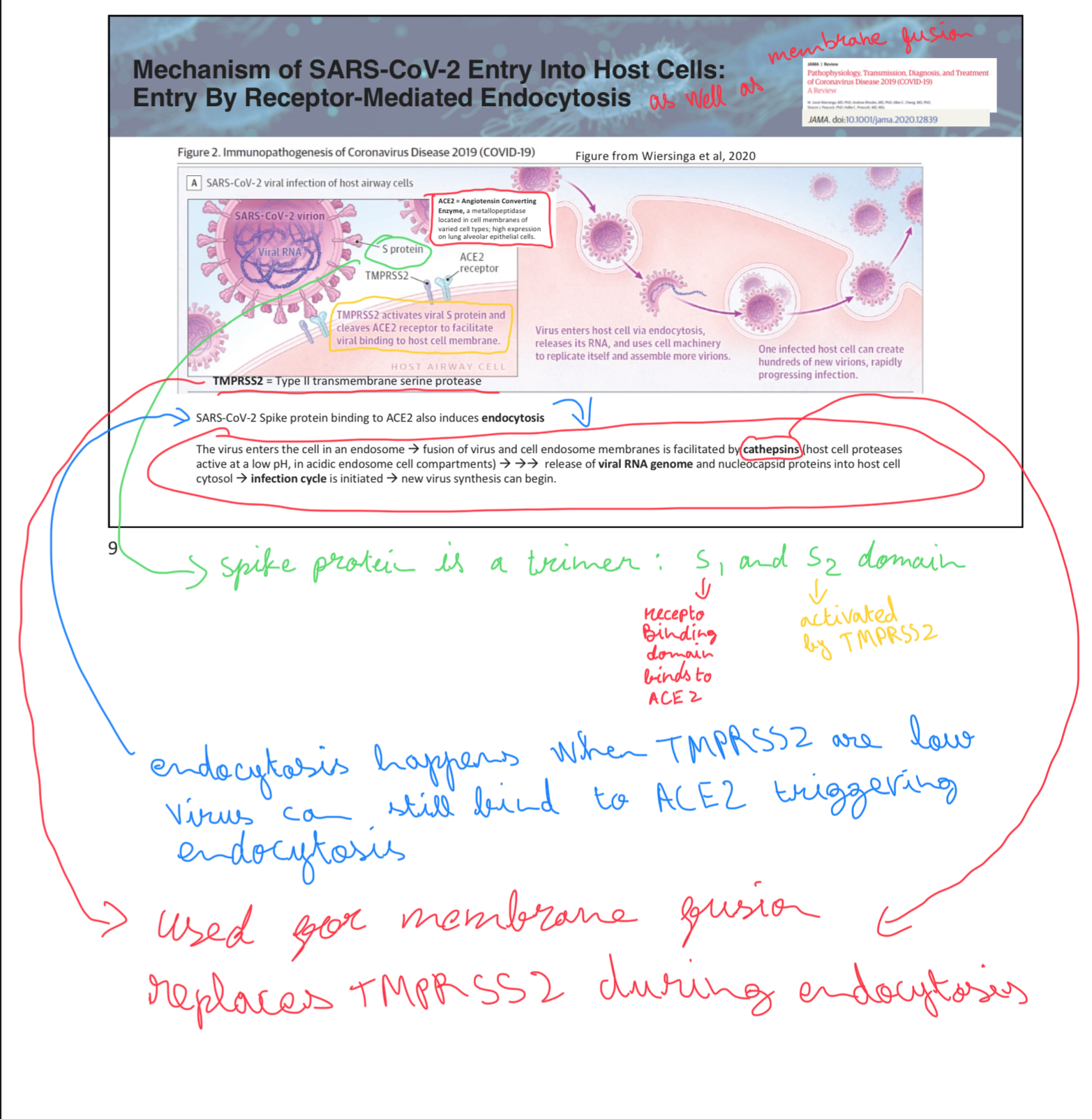Microbio lec9 Viral Infection, Replication, and RNA Virus Profiles
1/55
There's no tags or description
Looks like no tags are added yet.
Name | Mastery | Learn | Test | Matching | Spaced |
|---|
No study sessions yet.
56 Terms
What mechanism allows enveloped viruses to enter host cells?
A. Passive diffusion
B. Phagocytosis
C. Direct penetration
D. Receptor-mediated endocytosis
D
What distinguishes naked viruses from enveloped viruses during cell entry?
A. Naked viruses attach directly, while enveloped viruses utilize fusion
B. Naked viruses enter through endocytosis, while enveloped viruses do not
C. Naked viruses have a protein coat, while enveloped viruses have a lipid membrane
D. Naked viruses attach directly, while enveloped viruses fuse with the nucleus
A
Describe the process of membrane fusion in viral entry into host cells.
Viral membrane fuses with host cell membrane. Viral glycoproteins mediate the fusion, allowing the viral genome to enter the host cell.
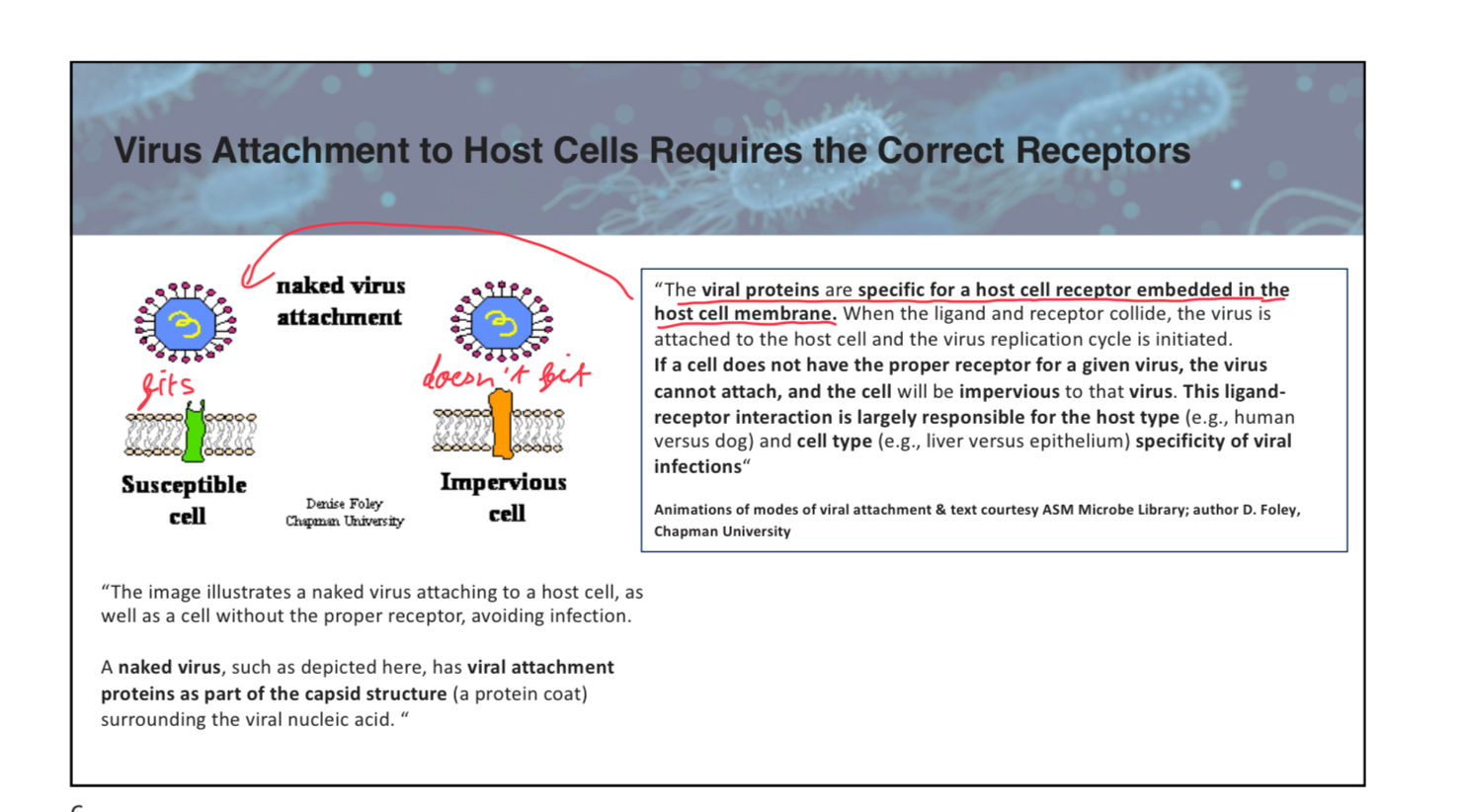
Explain how viral specificity for host cells is determined.
Matching of viral proteins & specific host receptors determines cell infection.
pt1 slide6

Discuss the role of macrophages and dendritic cells in the immune response to rhinovirus infections.
During major group RV infection
Macrophages: Release anti-inflammatory cytokines, slowing activation of fighting T cell.
Dendritic cells: Release anti-inflammatory cytokines and interact with Helper T cells to reduce antibody production.
During minor group RV infection
Macrophages: Release pro-inflammatory cytokines, increasing T cell activation.
Dendritic cells: Release pro-inflammatory cytokines and interact with Helper T cells to increase antibody production.
pt1slide9
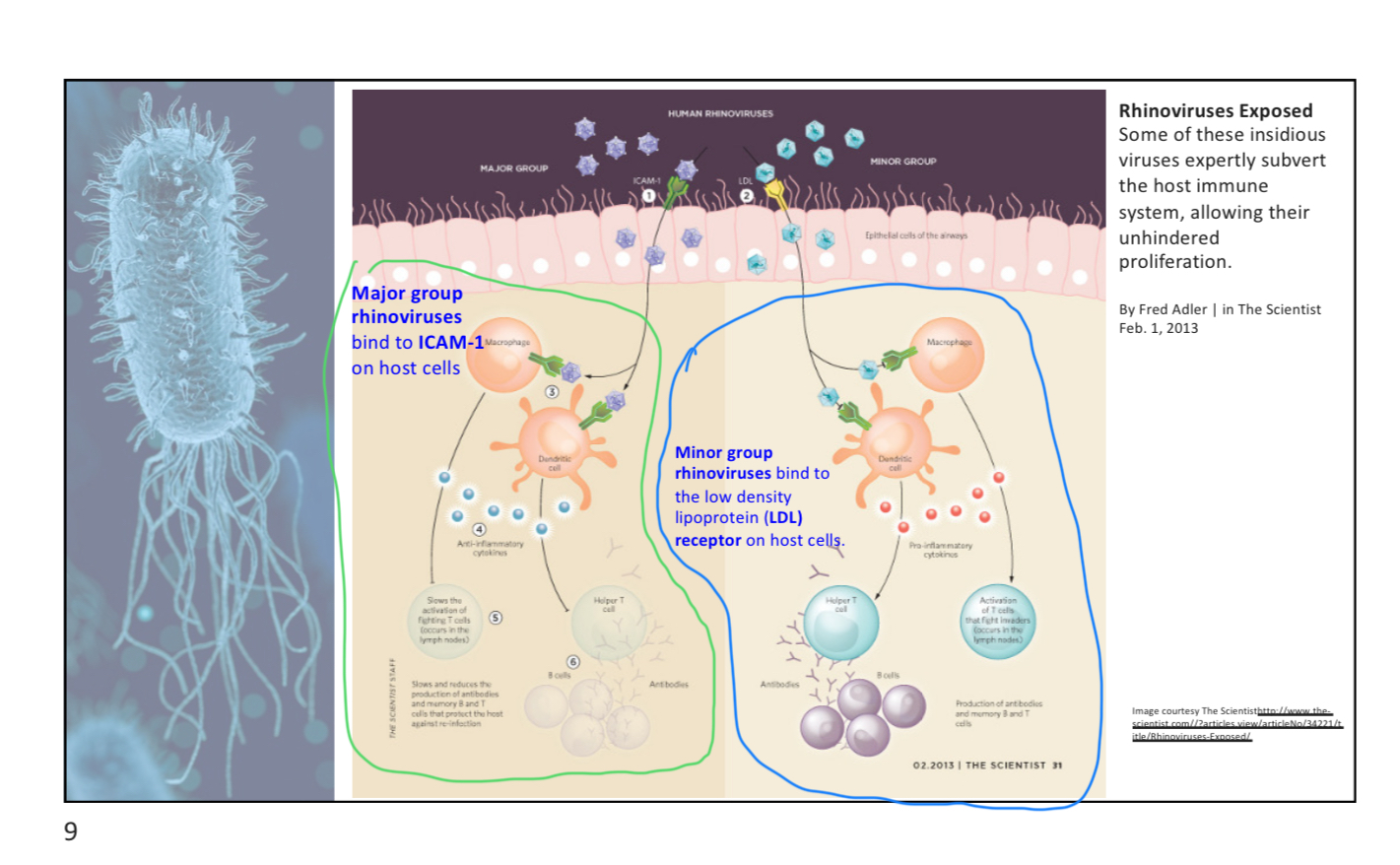
What are the differences between the major and minor groups of rhinoviruses in terms of their entry mechanisms?
Major group: bind to ICAM-1 receptors on host cells.
Minor group: bind to LDL receptors.
Which type of virus replicates DNA from an RNA intermediary?
A) Herpes virus
B) Hepatitis B virus
C) Influenza virus
D) Poliovirus
B
Hepatitis B virus is a retrovirus-like virus that replicates its DNA from an RNA intermediary through reverse transcription. It carries its own reverse transcriptase enzyme, which converts its RNA genome into DNA inside the host cell.
True or False: Most RNA viruses replicate in the nucleus
False (most replicate in the cytoplasm)
It’s most DNA viruses that replicate in the nucleus
Pt2slide6
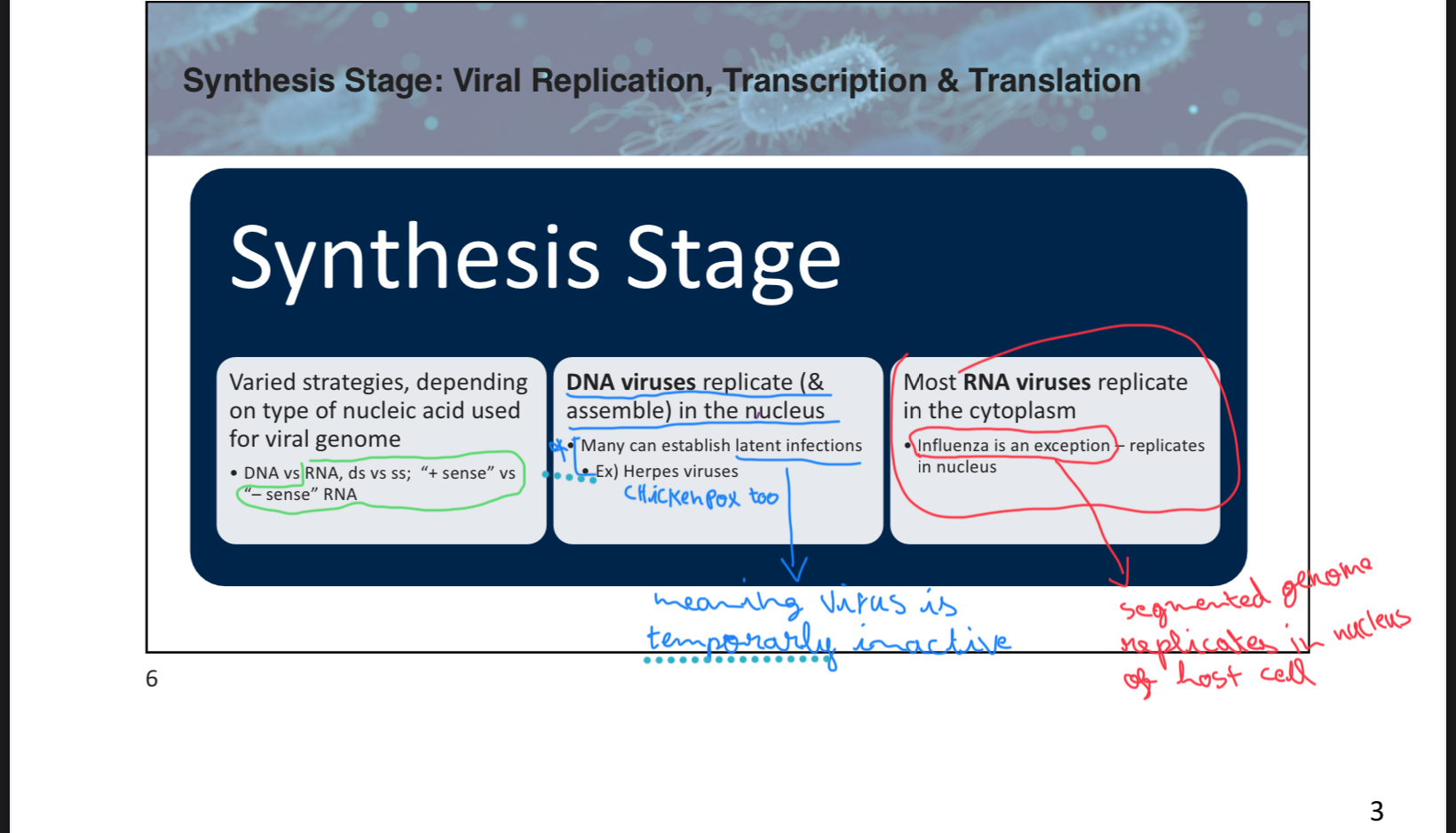
Negative-sense RNA viruses cannot serve directly as ________
mRNA (they need to synthesize a complementary + sense RNA)
Which of the following is NOT a type of RNA virus?
A) +ss RNA
B) -ss RNA
C) ds RNA
D) +ds RNA
D
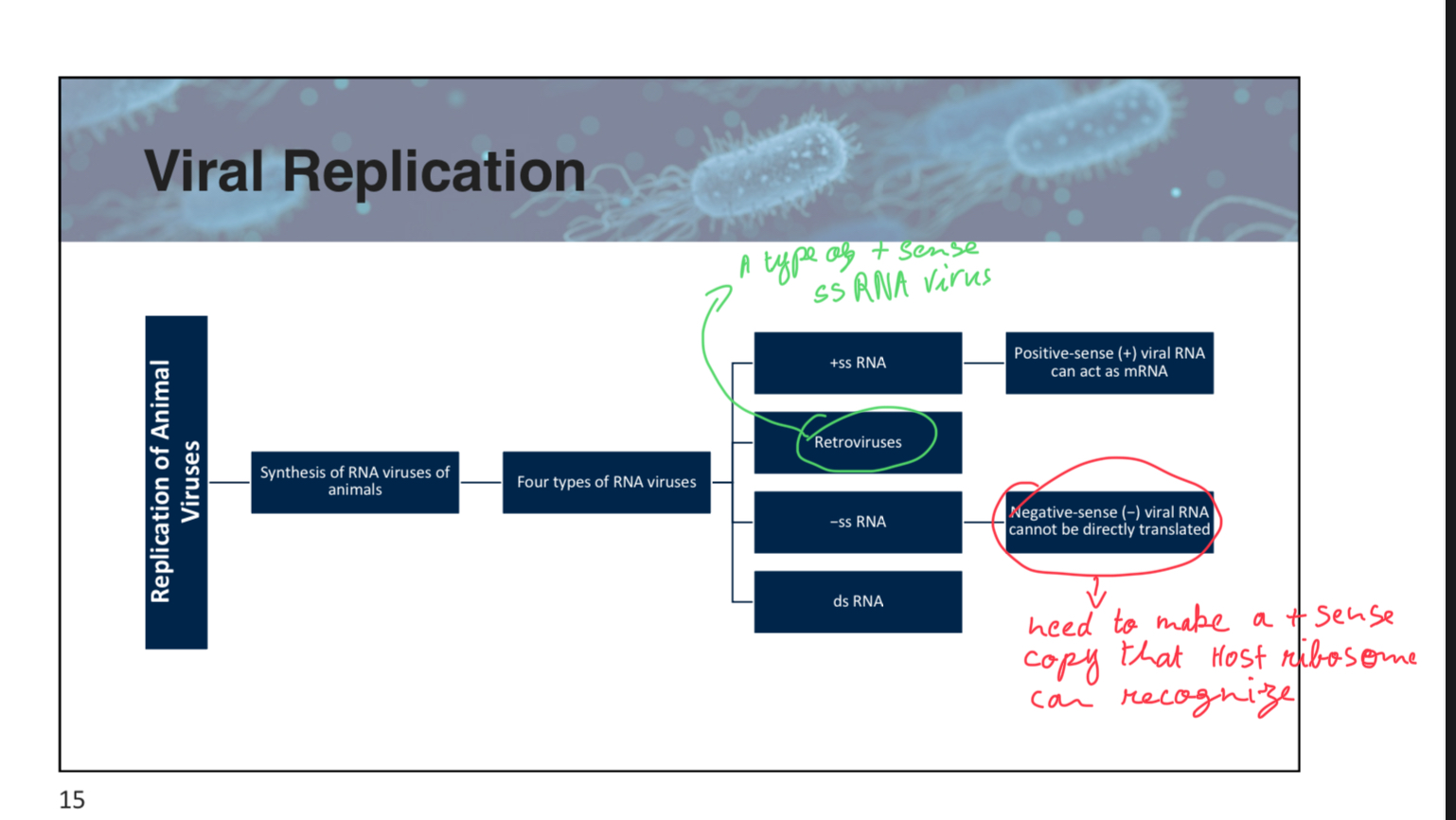
What enzyme is used by retroviruses to transcribe DNA from RNA?
A) DNA polymerase
B) RNA polymerase
C) Reverse transcriptase
D) Ligase
C
Which virus type uses its genome directly as mRNA?
A) +ssRNA viruses
B) -ssRNA viruses
C) dsDNA viruses
D) dsRNA viruses
A
True or False: Influenza virus replicates in the cytoplasm like most other RNA viruses.
False
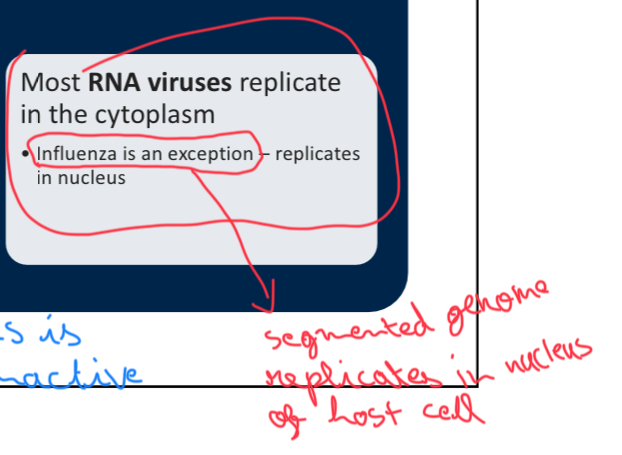
What is the primary method of release for naked viruses?
A) Budding
B) lysis
C) Endocytosis
D) Diffusion
B (+sense ss RNA virus like Poliovirus)
note; dsRNA virus also release by lysis or exocytosis
pt2slide16
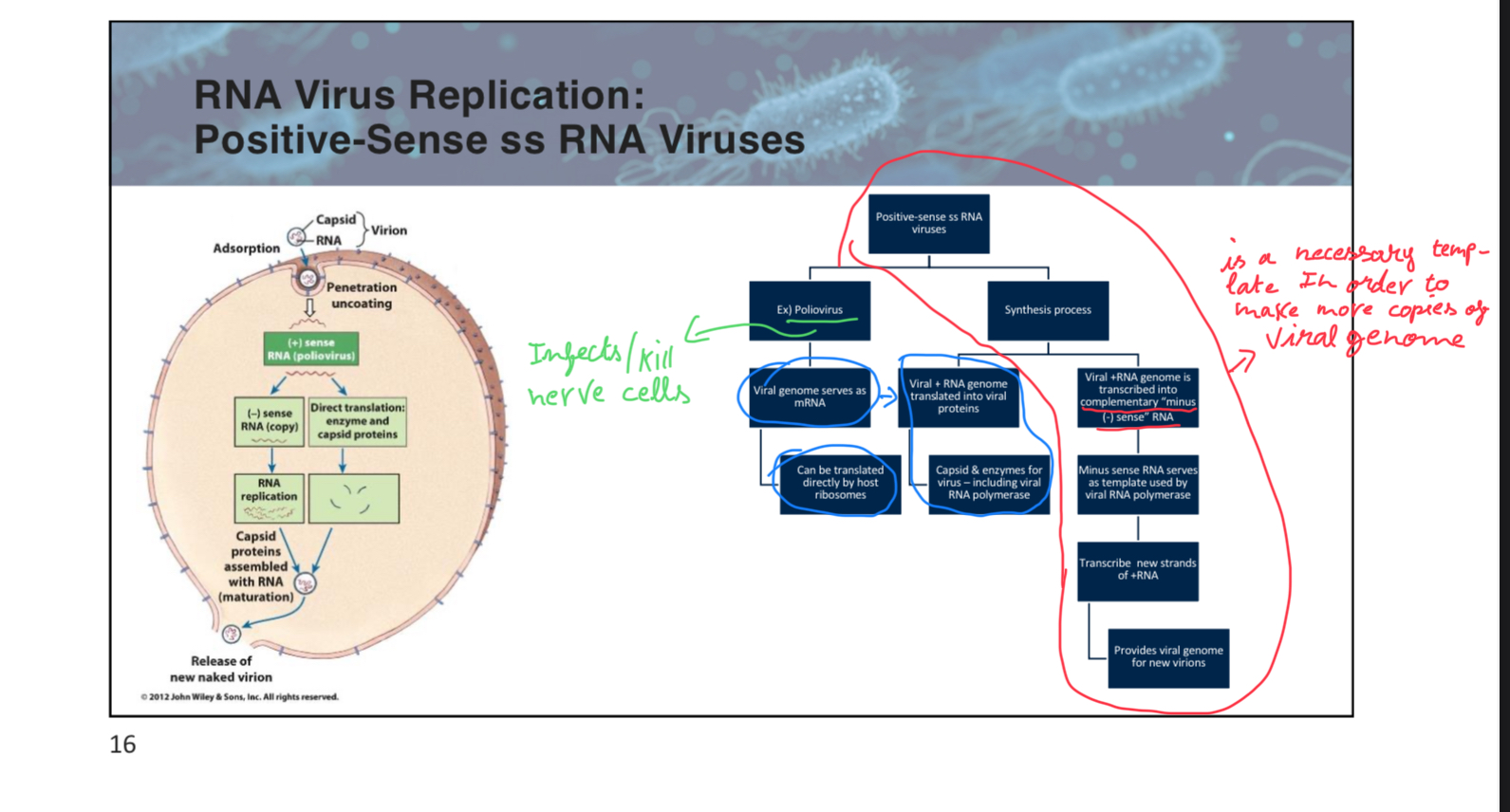
Which of the following is a characteristic of persistent viral infections?
A) Continuous shedding of virus particles
B) Rapid cell death
C) Immediate immune response
D) Complete viral clearance
A
True or False: ssDNA viruses use host cell DNA polymerase to reach a dsDNA stage during replication.
True
pt2slide10
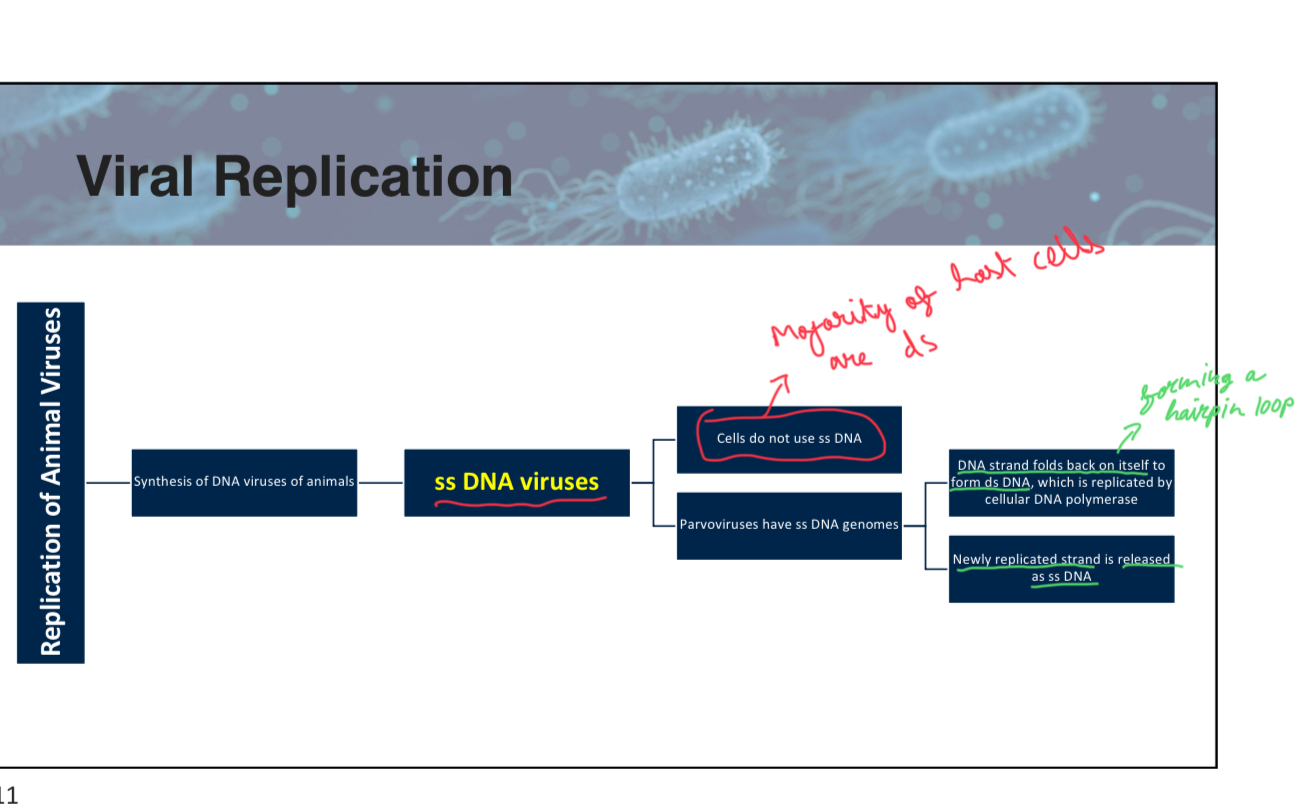
What type of virus is SARS-CoV-2?
A) dsDNA virus
B) -ssRNA virus
C) Retrovirus
D) +ssRNA virus
D
Explain the difference between how +ssRNA and -ssRNA viruses synthesize mRNA upon entering a host cell.
+ssRNA viruses can use their genome directly as mRNA for translation. -ssRNA viruses cannot use their genome directly as mRNA and must first transcribe their negative-sense RNA into complementary positive-sense RNA using a viral RNA-dependent RNA polymerase before translation can occur.
What are the main stages of the viral "life cycle"? Briefly describe each stage.
The main stages are: 1) Attachment: virus binds to host cell receptors. 2) Entry: virus penetrates the cell membrane. 3) Uncoating: viral genome is released. 4) Synthesis: replication of viral nucleic acids and production of viral proteins. 5) Assembly: viral components are assembled into new virus particles. 6) Release: new viruses exit the host cell through lysis or budding.
How do enveloped viruses differ from naked viruses in terms of their release from host cells?
Enveloped viruses typically exit host cells through a process called budding acquiring a lipid envelope from the host cell membrane
Naked viruses usually exit by causing cell lysis or through exocytosis.
Enveloped viruses can often leave the host cell alive, while naked viruses typically cause cell death upon release.
Explain the role of reverse transcriptase in retrovirus replication.
Reverse transcriptase in retroviruses transcribes the viral RNA genome into double-stranded DNA. This DNA can then integrate into the host cell's genome as a provirus. The integrated viral DNA serves as a template for producing new viral RNA genomes and mRNA for viral proteins, allowing the virus to replicate and produce new virions.
What type of genetic material does HIV contain?
A) Double-stranded DNA
B) Single-stranded RNA
C) Double-stranded RNA
D) Both A and C
B (contains 2 + sense ss RNA V.)
pt3 slide5
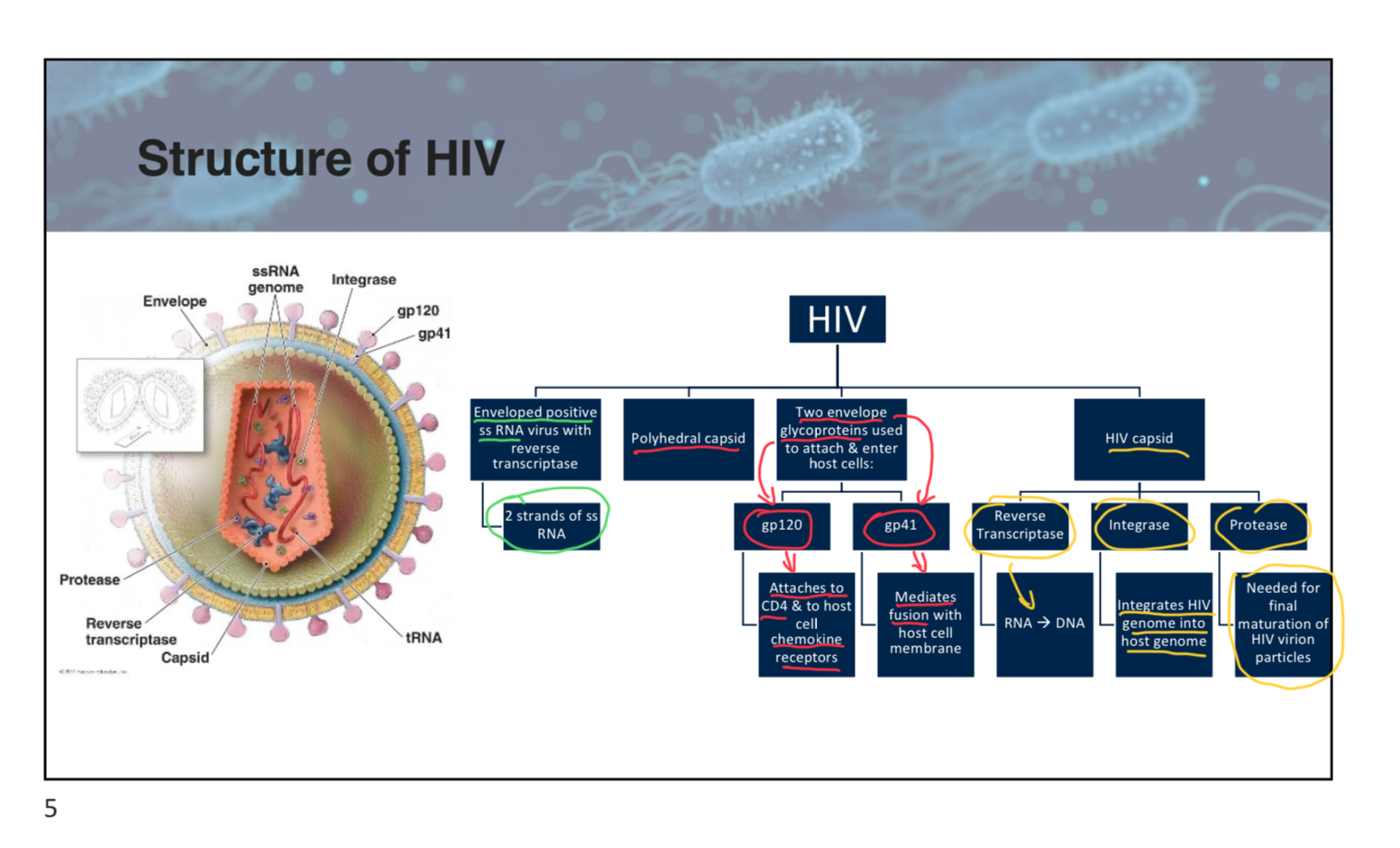
HIV uses the enzyme _______________ to convert its RNA into DNA.
reverse transcriptase (HIV is a retrovirus)
True/False: HIV primarily infects B cells.
False (it infects T cells)
Which of the following is a primary function of gp41 in HIV?
A) Fusion with the host cell membrane
B) Attachment to CD4 receptors
C) Integration into the host genome
D) Conversion of RNA to DNA
A (it facilitates fusion of HIV with host cell membrane)
pt3 slide9
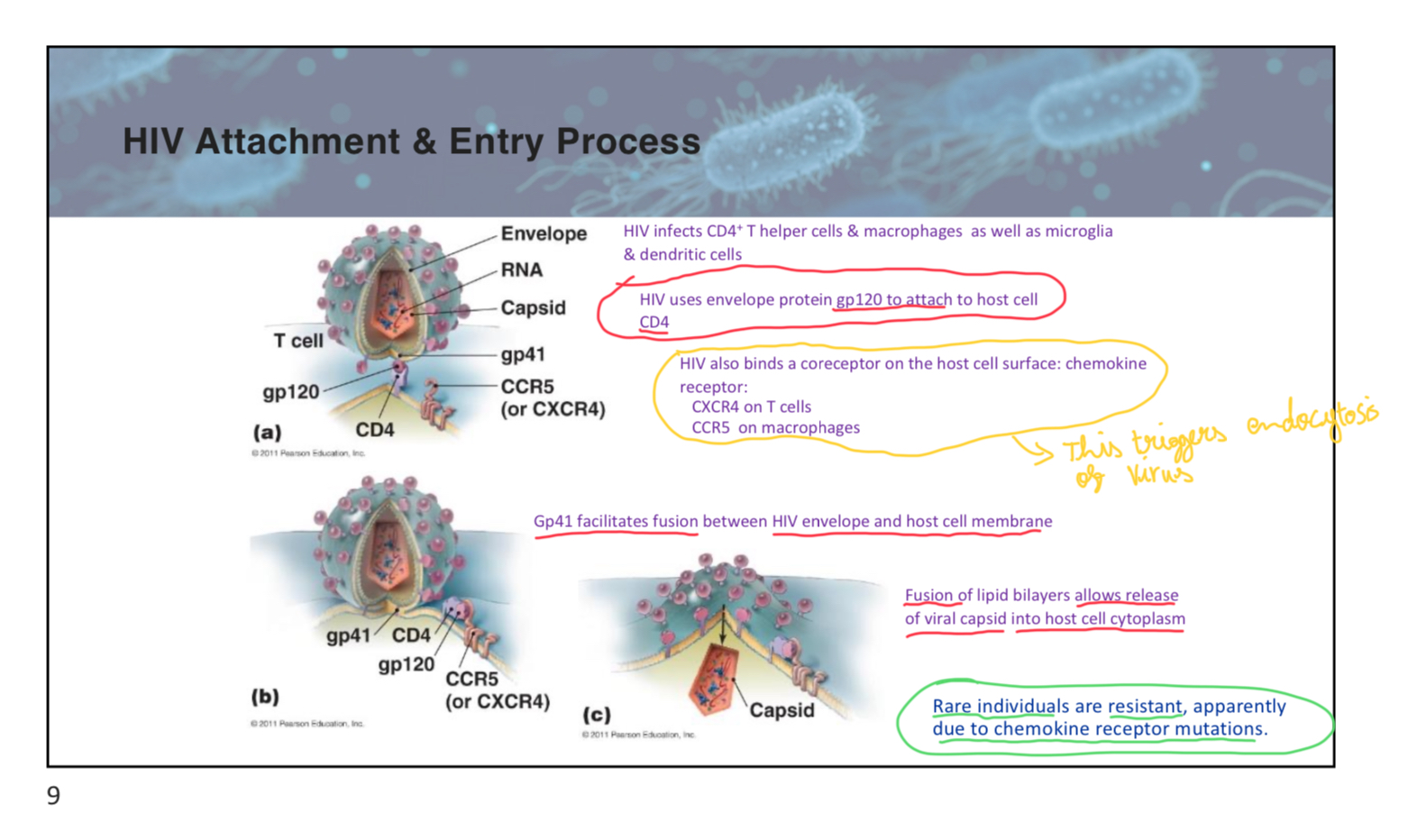
HIV integrates its genome into the host cell chromosome using the enzyme _______________.
Integrase
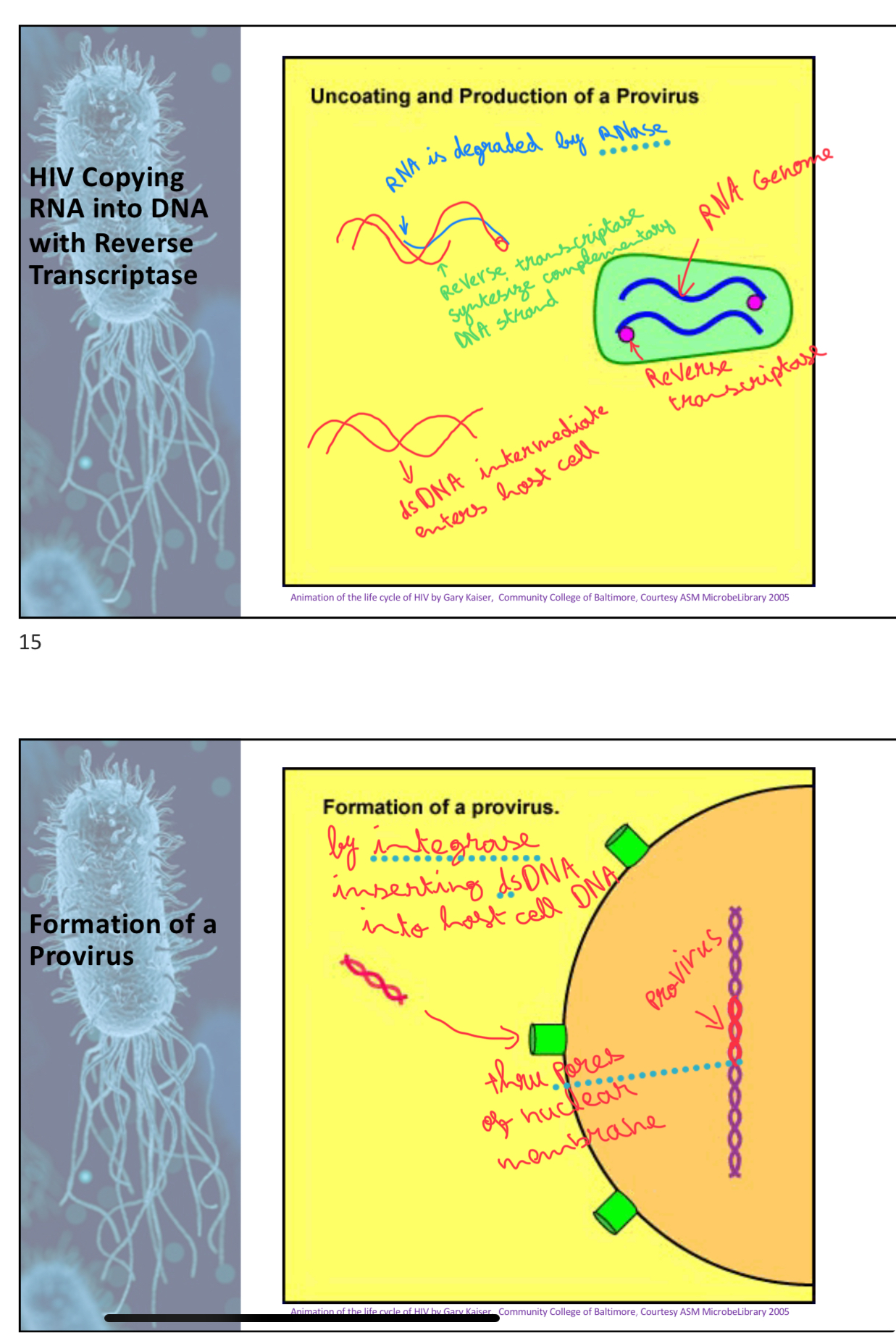
True/False: HIV can remain dormant in host cells for extended periods.
True (latency phase)
HIV targets and depletes _______________ cells, which are crucial for immune response.
CD4* T helper (as well as macrophages and dendritic cells)
True/False: Anti-retroviral therapy (ART) can cure HIV infection.
False (It can manage it but not cure it. Therefore in infected patients it must be maintained)
pt3slide25
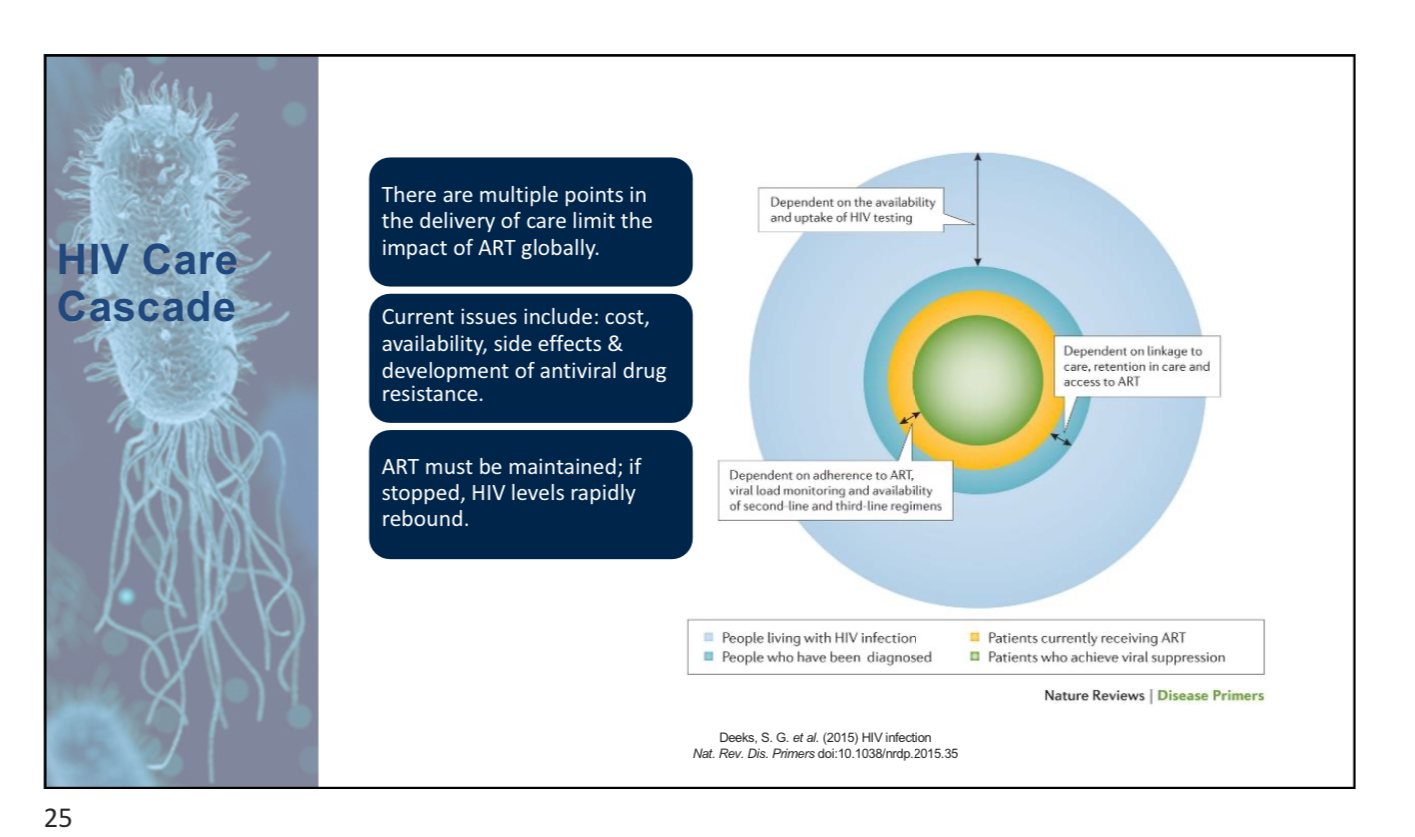
What is the role of gp120 in HIV infection?
A) Mediates fusion with host cell membrane
B) Attaches to CD4 receptors and chemokine receptors
C) Converts RNA to DNA
D) Integrates viral genome into host DNA
B
Which region has the highest prevalence of HIV?
A) North America
B) South America
C) Sub-Saharan Africa
D) Southeast Asia
C
HIV can infect the _______________, leading to accelerated thymic loss.
Thymus
Describe the stages of HIV infection, from primary infection to the latent period
Primary infection involves a burst of virion production and symptoms like fever. The latent period follows, during which the virus may remain dormant before gradually depleting T cells
Describe the process by which influenza viruses enter host cells.
Influenza viruses enter host cells through a process initiated by hemagglutinin attachment, which induces endocytosis.
The virus is enclosed in an endocytic vesicle, and acidification causes a change in the virus capsid protein conformation, leading to fusion of the virus envelope with the vesicle membrane and release of the viral genome into the cytoplasm.
pt4 slide7
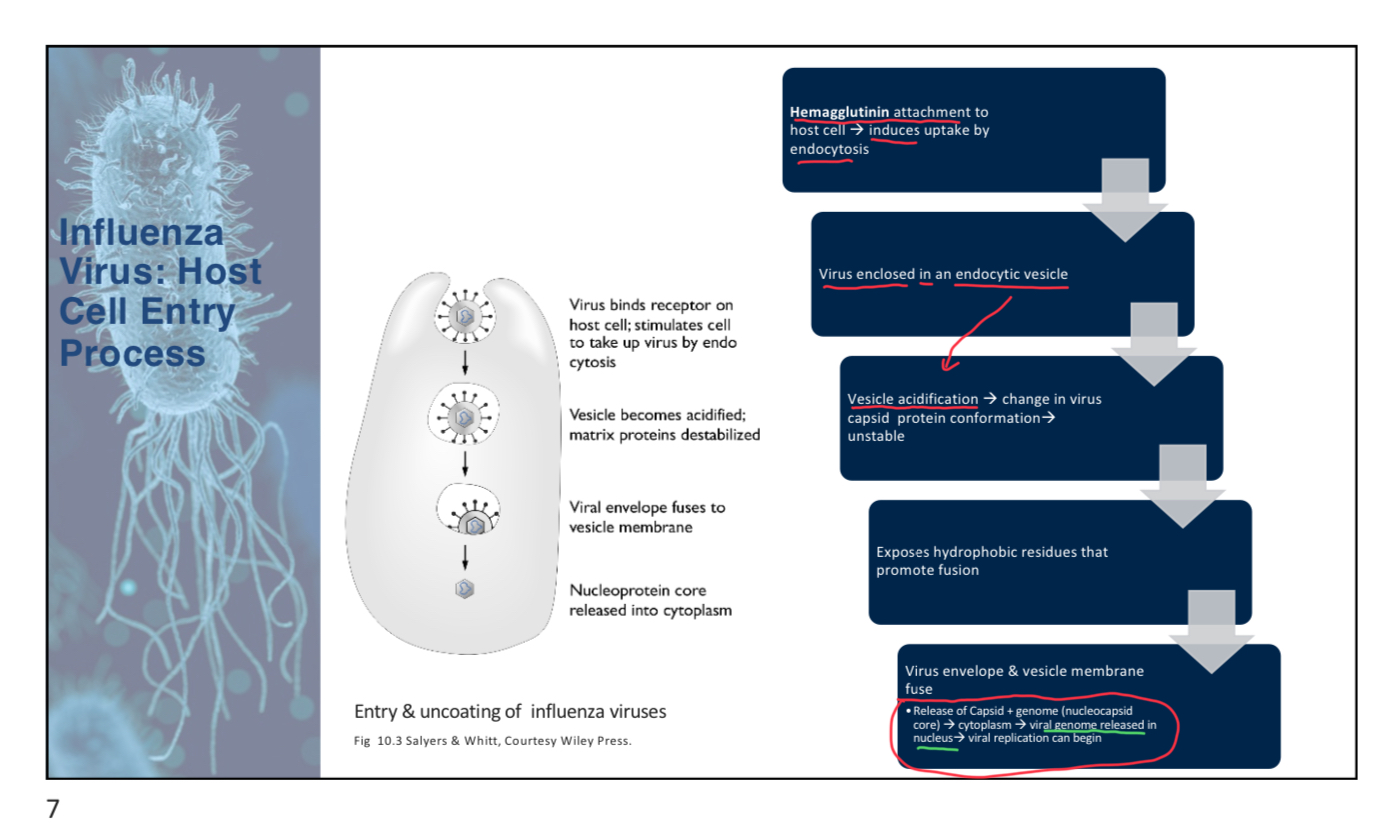
What type of viral infection is typically caused by influenza viruses?
A) Latent infection
B) Chronic infection
C) Tumour infection
D) Acute infection
D
Which of the following is a characteristic of influenza viruses?
A) Enveloped, helical-shaped, segmented negative sense ssRNA genome
B) Enveloped, spherical-shaped, positive sense ssRNA genome
C) Non-enveloped, helical-shaped, double-stranded DNA genome
D) Non-enveloped, spherical-shaped, single-stranded RNA genome
A
pt4 slide3
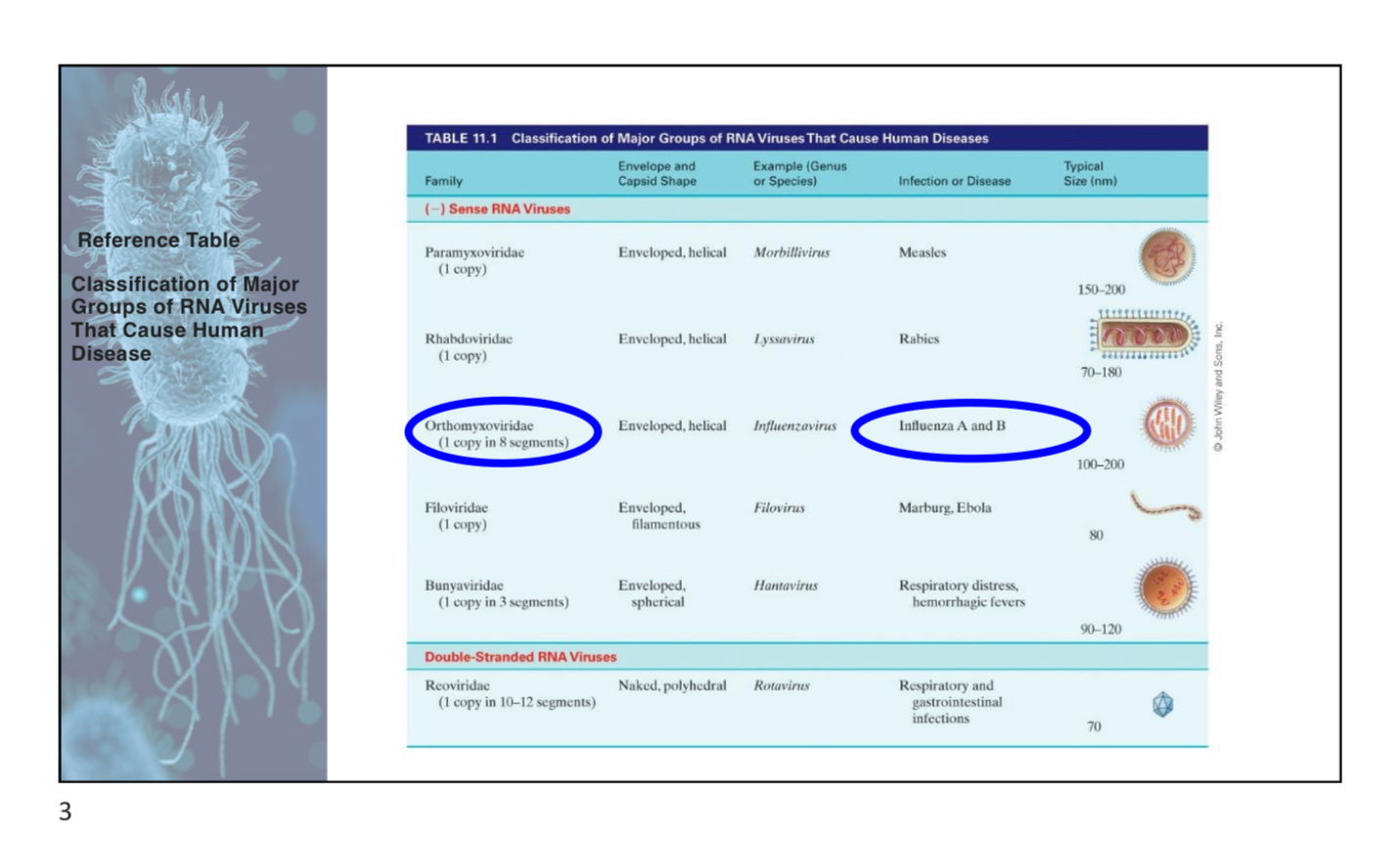
The severity of influenza symptoms varies with the ________________________.
Strain (new strain can be minor or major)
pt4 slide10
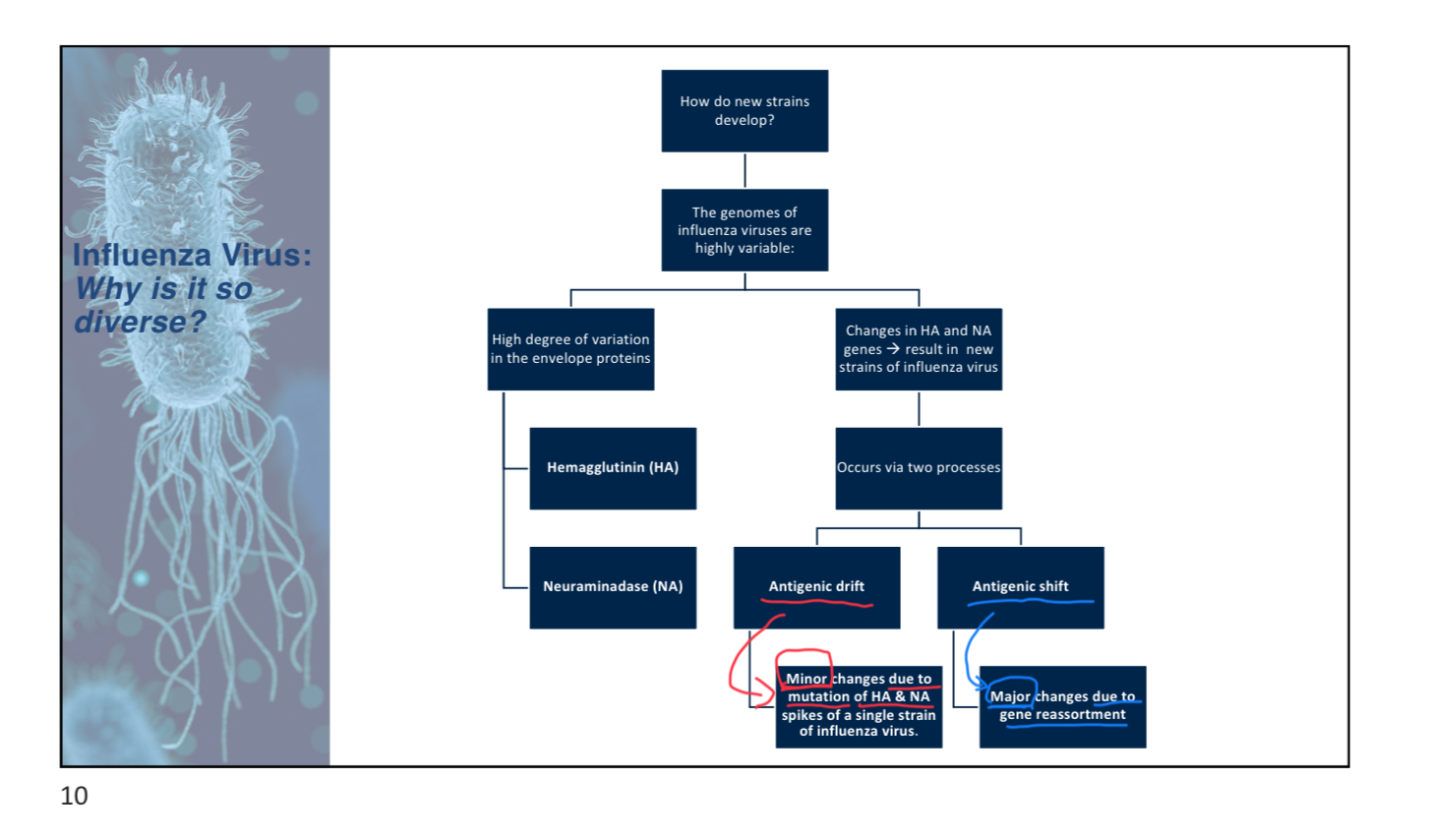
What is the role of neuraminidase in the influenza virus life cycle?
A) Attachment to host cells using spike proteins
B) Transcription of viral genes
C) Replication of the viral genome with reverse transcriptase enzyme
D) Release of mature viral particles from host cells
D
The process of ________________________ leads to minor changes in the HA and NA spikes of a single strain of influenza virus.
Antigenic drift
True/False: Avian influenza viruses like H5N1 have sustained human-to-human transmission.
False (it has potential to develop ability to spread from human to human)
Note; this strain has a fatality rate of ~60%

Explain how antigenic drift and antigenic shift contribute to the diversity of influenza viruses.
Antigenic drift involves minor changes in the HA and NA spikes due to mutations, while antigenic shift involves major changes due to gene reassortment between different strains, both contributing to the diversity of influenza viruses.
How do avian influenza viruses like H5N1 and H7N9 pose a threat to human health?
Avian influenza viruses like H5N1 and H7N9 pose a threat due to their potential for severe infection and high mortality rates. Although they primarily spread through contact with infected animals, there is concern about their potential to develop human-to-human transmission capabilities.
pt4 slide15
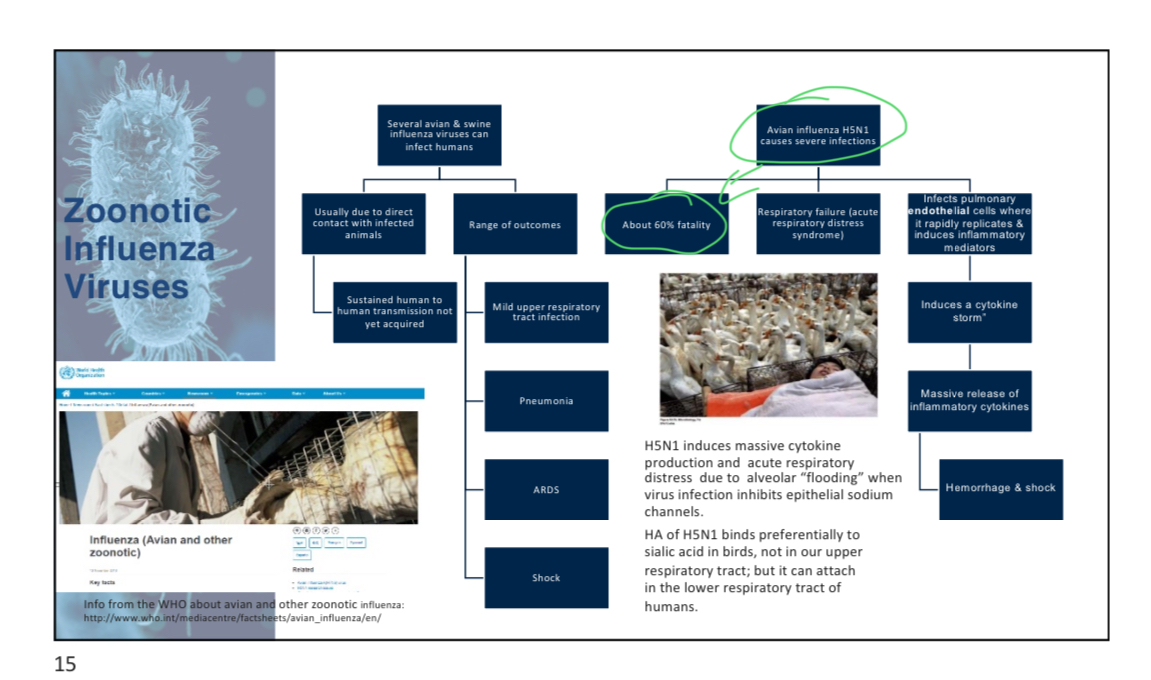
Zika virus is primarily transmitted to humans through:
A) Contaminated food
B) Airborne droplets
C) Aedes mosquitoes
D) Direct contact with infected individuals
C
True/False: Zika virus was first discovered in Africa.
True (was only recently discovered in the western hemisphere)
Besides mosquito bites, Zika virus can also be transmitted via ________________ and ________________ routes.
transplacental and sexual
Note: transplacental infection cause microcephaly (shrinking of baby head). Also this virus can be asymptomatic.
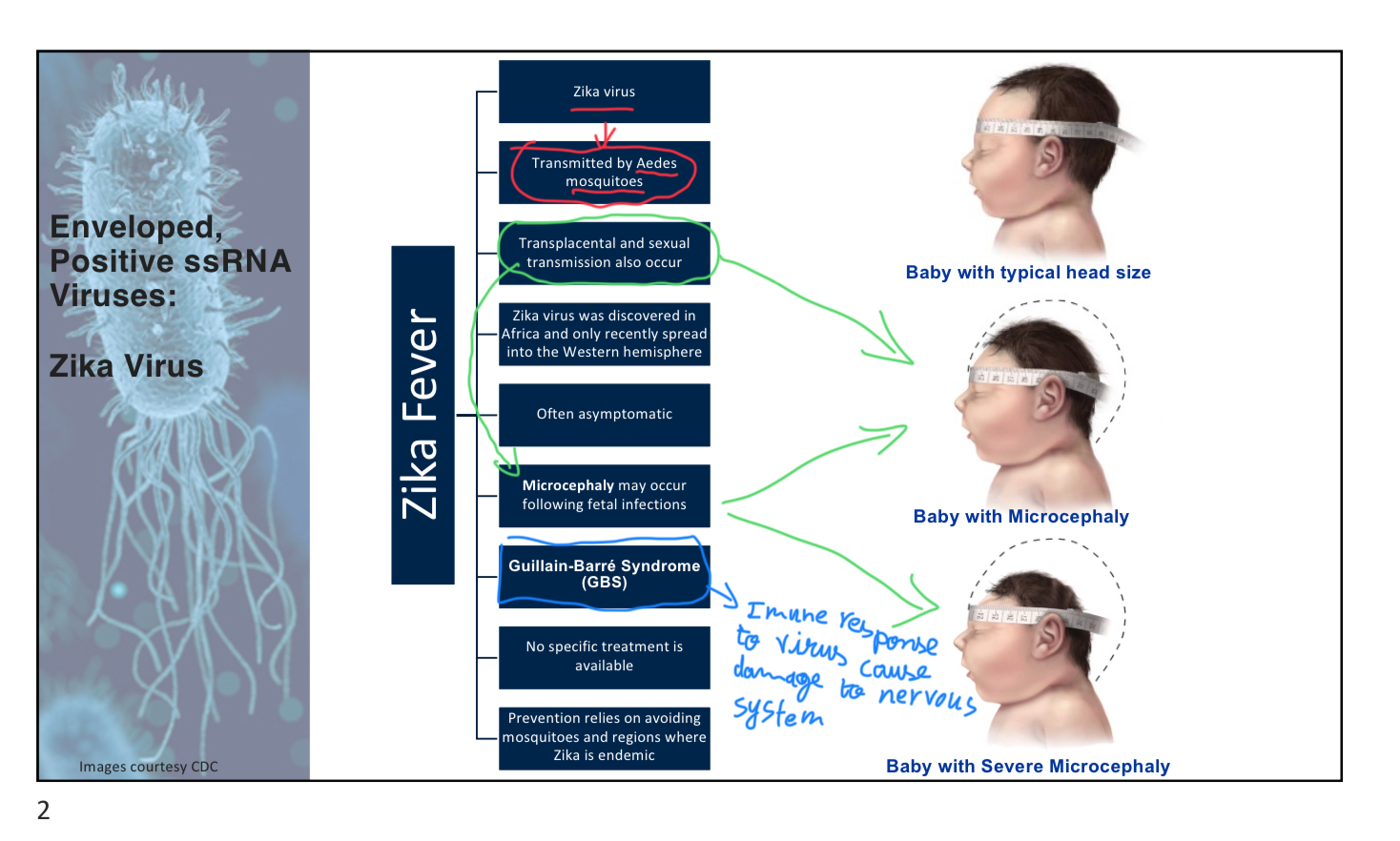
True/False: A specific treatment is currently available for Zika virus infection
False (There are currently no cure)
Describe the symptoms of Zika virus.
Headache, macropapular rash, fever, back pain, joint pain
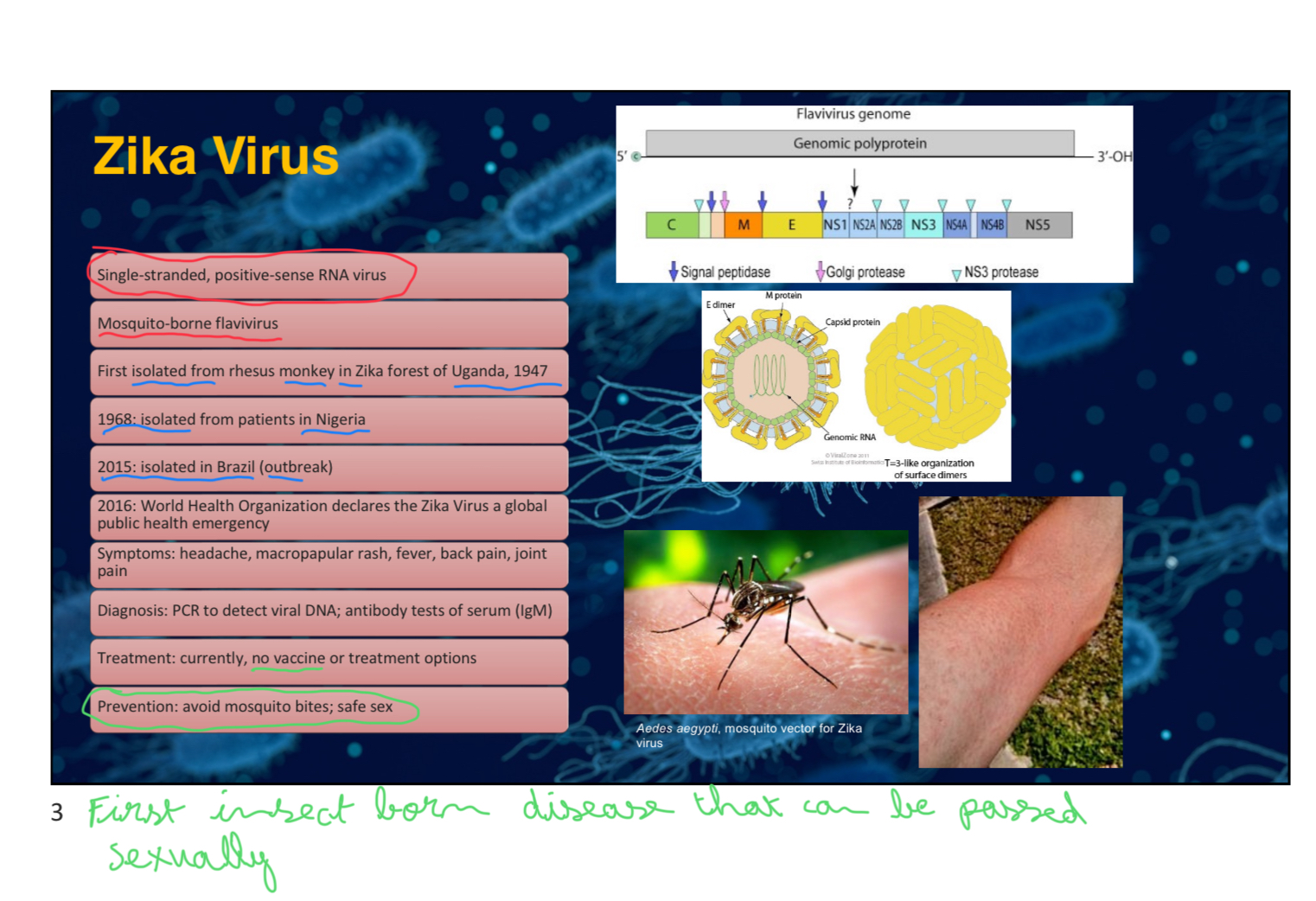
Zika is the first ____________________
insect born disease that can be passed sexually
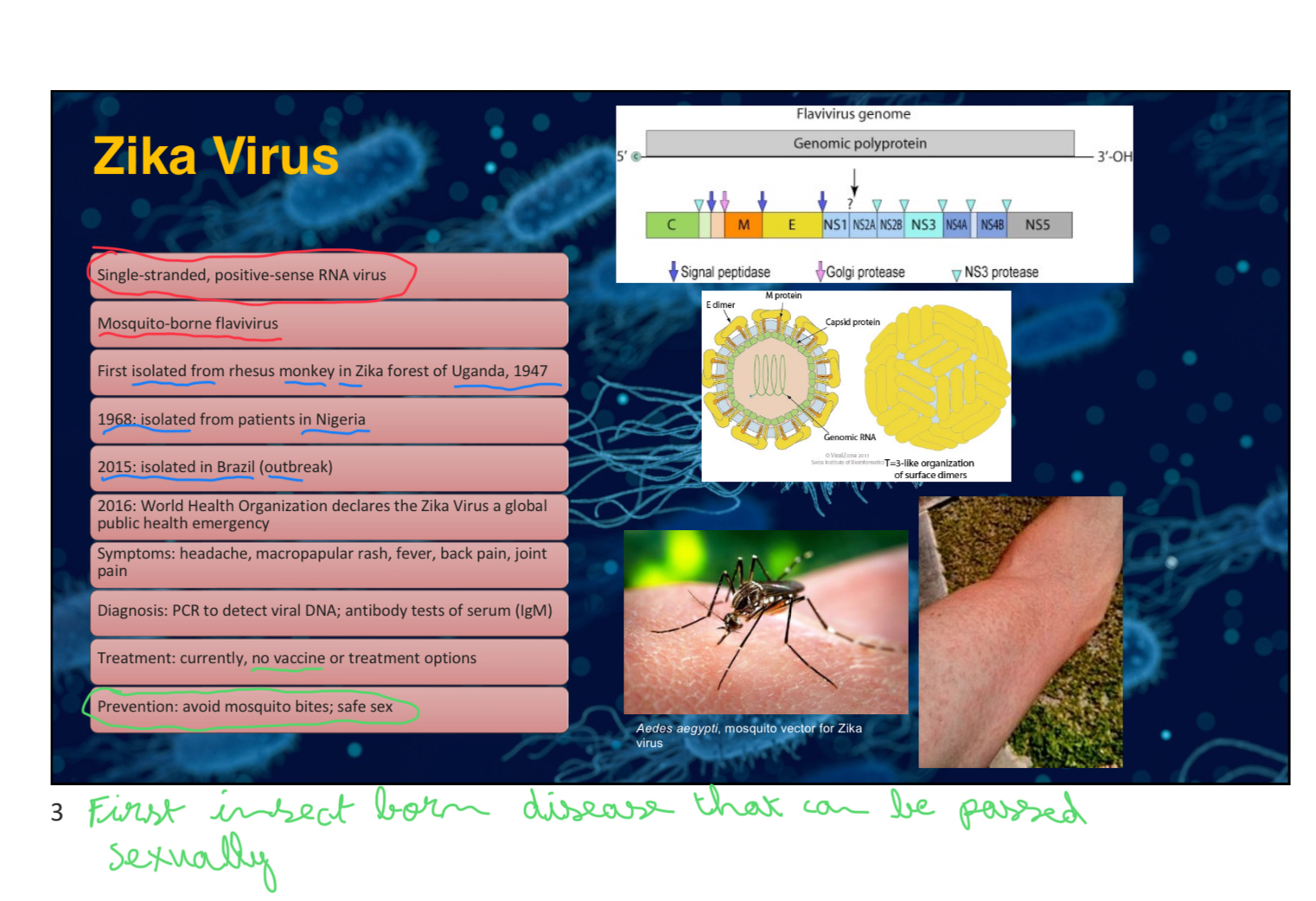
What type of virus is Zika
Single-stranded, positive-sense RNA virus/Mosquito-borne flavivirus
What is Guillain-Barré Syndrome (GBS), and how is it linked to the Zika virus
GBS occurs when the immune response to a pathogen (such as Zika virus) results in nerve cell damage, causing muscle weakness, and sometimes, paralysis.
Coronaviruses are named for the corona-like halo formed by their:
a) Nucleocapsid
b) Spike protein
c) mRNA genome
d) Lipid Bilayer
B
True/False: Coronaviruses are the most common cause of colds.
False (influenza is 1st)
True/False: SARS and MERS are examples of Coronavirus respiratory syndromes
True
Which of the following is NOT a structural protein of SARS-CoV-2?
A) S
B) M
C) N
D) ACE2
D
S – spikes on the outside; mediates receptor binding
M – membrane protein; assists viral assembly
N – nucleocapsid protein; regulation of viral RNA synthesis, may interact with M protein during virus budding
E – small envelope protein; function necessary but not fully understood
Describe the corona virus structure
Medium-sized virus size, but largest mRNA genome
Enveloped +ve stranded RNA
mRNA encased in nucleocapsid
Describe the role of ACE2 in the entry of SARS-CoV-2 into host cells.
ACE2 (Angiotensin Converting Enzyme) is a metallopeptidase located in cell membranes. The SARS-CoV-2 Spike protein binds to ACE2, which induces endocytosis and allows the virus to enter the host cell.
pt6 slide 9
